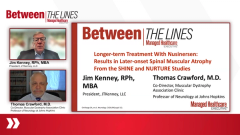
Examining Patient Characteristics from SHINE Study
Further discussion of the SHINE study explores characteristics unique to the trial's patient population.
Episodes in this series

Dr. Crawford discusses the patient characteristics in the context of the EMBRACE, CHAIR, and SHINE studies, focusing on comparing children in the nusinersen study who received the drug versus those who received the sham. The randomization was 2:1, with twice as many receiving the drug. Age ranges and durations on the drug were similar. Notably, it's emphasized that this is the last sham control study in spinal musculature due to ethical concerns. Three approved SMA therapies are highlighted: nusinersen, risdiplam, and zolgensma. The ethical dilemma is underscored, acknowledging the sacrifices of sham patients who contributed to the drug approval process, seen as "wounded warriors" enabling a molecular revolution. The journey, though messy initially, emphasizes the importance of recognizing the challenges and ethical considerations in proving therapy efficacy.
Video synopsis is AI-generated and reviewed by Managed Health Care Executive editorial staff.
Newsletter
Get the latest industry news, event updates, and more from Managed healthcare Executive.



















































